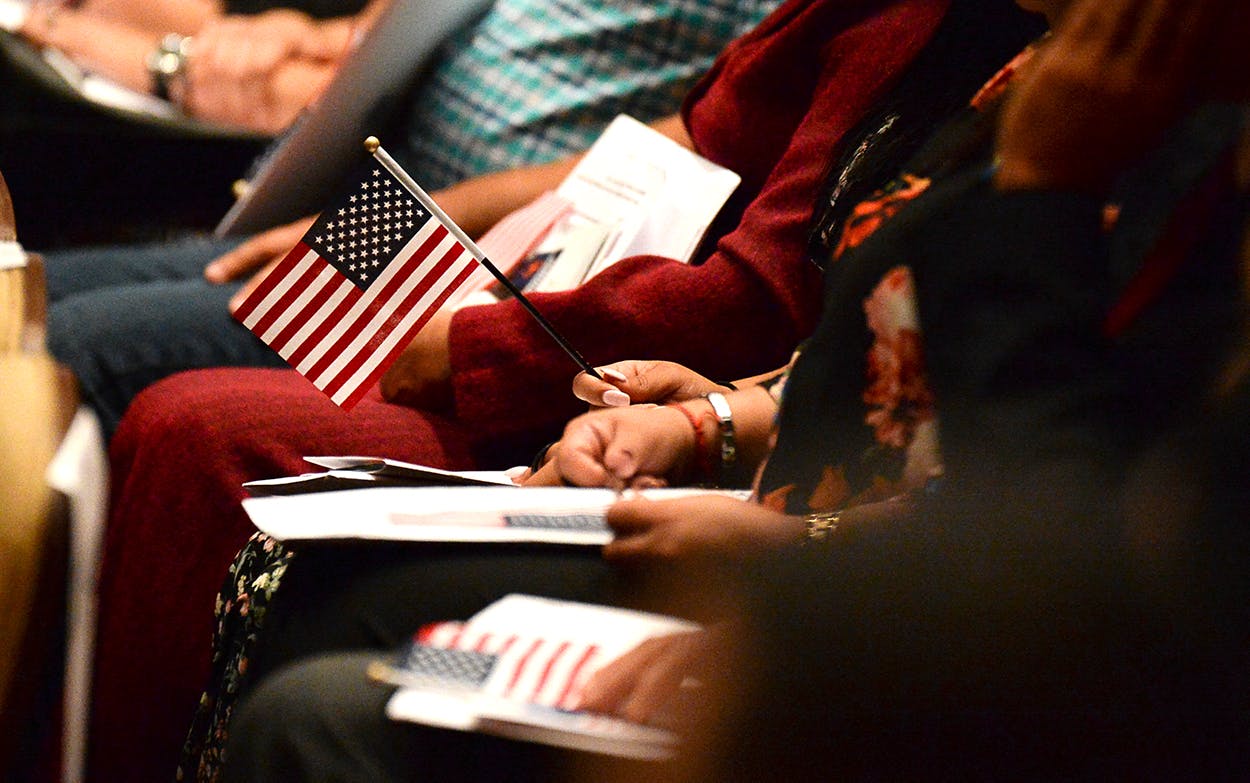To become U.S. citizens, Maria Garcia and her family had to give up their truck. They had to say goodbye to priceless keepsakes like her little sister’s gold pendant. They had to postpone her quinceañera—a milestone she’d anticipated her entire childhood. Raising the thousands of dollars necessary to navigate the naturalization process meant eight long years of such sacrifices.
“I remember my mom always telling me that it was just temporary,” Garcia says. “We could always get our things back or replace them at some point, but this is what we had to do. That’s when I realized what they were putting on the line for us to do this.”
Her mother brought her across the Rio Grande from Durango, Mexico, when she was just two months old, in the summer of 1994. Her parents hoped a move to Texas might mean better opportunities for her. Her father, Jose, applied for permanent residency that same year, but the request wasn’t processed until 17 years later, in 2011. That first step cost the family nearly $4,000—a steep price for parents working manual labor jobs while raising two kids. After maintaining their U.S. residence for another five years, they spent the next year saving the additional $2,175 in fees they’d need to pay before finally filling out their citizenship applications in 2017.
For many aspiring Americans, the financial costs associated with applications and attorney fees pose the biggest challenge to seeking citizenship. In Texas, they’re up against a few additional barriers. According to United States Citizenship and Immigration Services data compiled by Boundless, a Seattle-based startup aiming to simplify naturalization, field offices in multiple Texas metros rank among the top ten for longest average wait times and lowest approval rates in the country. Boundless co-founder and CEO Xiao Wang says that what’s missing from the data is the reason why the processing times vary greatly from place to place.
While border cities with high immigrant populations like McAllen and Harlingen make the top ten lists for long wait times and worst backlogs, some cities farther from the border—including Houston, Dallas, and Austin—often outrank them. Field offices in Houston and Dallas receive the highest number of citizenship applications in the state each year, but even still, they’re ranked as less efficient than offices in more populous cities like New York, which receives nearly twice as many applications. Because the application process is uniform across the country, it’s unclear what accounts for the differences. A representative for USCIS declined our request for comment.
Last March more than 100,000 citizenship applications in Texas were pending approval—a number that has more than doubled since 2016, with the state’s backlog second only to California’s. In all five of the state’s field offices (where applicants must go for scheduled interviews), average wait times vary between ten and seventeen months, while maximum wait times are more than eighteen months. By contrast, just two years ago, USCIS estimated the average national wait time to be closer to five and a half months. For some, these delays mean holding off on taking certain jobs or not being able to vote while waiting for applications to go through.
Garcia filed her naturalization paperwork in February 2017 and waited a whole year before hearing back. “Waiting for a response was probably the most nerve-racking experience,” she says. “At the time there were a lot of shifts in the law, and I was always trying to keep up with the changes.”
While there’s been a steady increase in the number of people applying for citizenship during the past several years, Houston immigration attorney Jennifer Correro says other factors contribute to the slow processing times. Changes in government administrations often mean changes to the process. During Obama’s presidency, the application form went from 10 to 21 pages. Under President Trump, internal policy changes meant that any applicants convicted of even minor crimes had to be referred to a supervisory level for review, lengthening the process.
In addition, one of the biggest differences Correro has noticed during the past two years involves the application fee. Families like Garcia’s often hold off on applying simply because they don’t have the money, so they spend years saving up. In the past, Correro could help applicants by requesting a waiver for clients who couldn’t afford the $725 charge. In 2016, she says, every single one of these requests was approved, but in 2018, she received approval for only two out of about twenty. During that same timeframe, her caseload has nearly doubled. “Sometimes it just feels like they’re looking for any reason to say no,” she says.
It’s crucial too that applicants provide all relevant materials and correctly fill out applications, which can be difficult without the help of attorneys—an additional, and sometimes out of reach, expense for many immigrant families. With the help of a lawyer and on advice from an uncle who had undergone the process years earlier, Garcia and her family reviewed years of documents—from grade-school attendance records to old rent checks—in order to prepare their applications.
On May 17, 2018—fifteen months after she filed her paperwork—Garcia became a naturalized citizen at a ceremony in Irving. She’d grown up listening to Tejano music, eating Tex-Mex food, and impatiently waiting for the bluebonnets to bloom on the side of the highways each year. She felt Texan, but she never thought she’d get to officially be one.
“When you come from a low-income family, and you see all the expenses you [need to] put into the attorney and the forms, it seems like something that can’t be reached,” Garcia says. “At the ceremony, I started crying when I hugged my mom. Without the risk she took for me 25 years ago, I wouldn’t have been there. Getting here is not an opportunity everyone has.”








